Of all the amenities that are available in your home, perhaps the most important is hot water.
Keeping clean is a fundamental building block of a healthy lifestyle. Without hot water, that’s a difficult thing to do.
Let’s look at what is inside your water heater and the various components that keep the water hot.
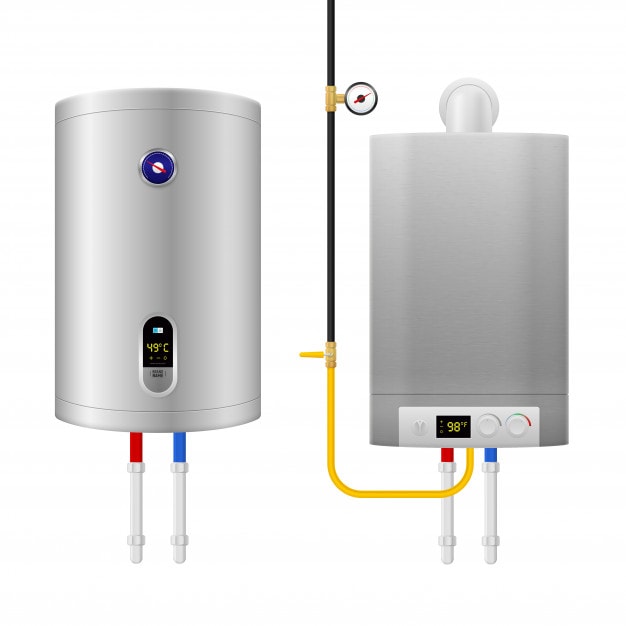
Water Heater Terminology and Common Concepts
In this article, we’ll deal with a gas or electric water heater. Several components are common to both water heaters:
Tank
The tank of a water heater consists of two parts. There’s an outer steel tank that encloses a high-pressure inner tank that holds the hot water. The inner tank is lined with a ceramic or plastic liner to prevent the tank from rusting. In between the inner and outer tanks, you’ll find a layer of insulation material.
Water Pipes
There will be two sets of water pipes connected to your heater.
The first is called a dip tube. The dip tube is the cold water inlet, and it’s a long pipe that extends almost to the bottom of the inner tank.
The second pipe will be the hot water outlet. The tank’s top is where the most scalding water can be found, so this tube extends a short distance into the tank.
Anode Rod
The purpose of the anode rod in your water heater is to attract rust-inducing ions in the water to itself, to prevent the inner tank from rusting. This rod extends deep into the tank and is usually made of aluminum or magnesium.
Thermostat
The thermostat is a simple piece of equipment that constantly tests the temperature of the water.

In a gas water heater, the thermostat produces a small electric current that responds to the water temperature. As the water temperature increases, so does the current, and as the temperature drops, so does the current. When a specific current is reached, the regulator will send gas to the burners to heat the water.
In an electric water heater, the thermostat works differently. In this case, the thermostat is made of two different metals sandwiched together to create a flat bar. As these metals heat up, they expand at different rates, so the bar bends. When it bends far enough in a particular direction, a connection is made and electricity is turned on to the element. As the bi-metal bar cools, it bends in the opposite direction. The connection is lost, turning off the electricity.
Temperature and Pressure Relief Valve (TP Valve)
This is another critical piece of safety equipment. It’s designed to relieve pressure from the inner tank. Suppose the pressure inside the inner tank rises to a dangerous level for any reason. In that case, this valve will allow water to escape to relieve this pressure. If this valve is not working correctly, the tank may explode, causing severe damage.
Drain Valve
This valve is located at the bottom of the tank. It’s used to drain water and sediment that accumulates at the tank’s bottom.
Gas Regulator, Burner, and Flue
As the name implies, this is only found on a gas water heater.
The gas line will feed the gas into a gas regulator (that includes the thermostat). The gas regulator will supply gas to the main burner and a smaller pipe to the pilot light, which will ignite the burner when water needs to be heated. The pilot light also includes a piece of equipment known as a thermocouple or flame sensor. This is an essential piece of safety equipment. It’ll prevent the gas regulator from supplying gas to the burner if the pilot light isn’t burning.
Running up the inner tank’s middle is a hollow tube that allows the exhaust gases from the gas burner to be vented to the outside. It also acts as a heat exchanger and helps to keep the water in the inner tank hot.
Electric Heater Elements
Electric water heaters have two elements (similar to this in an electric kettle) responsible for heating the water. The one installed at the bottom of the tank does most of the work, as that’s where the cold water is piped into the tank. The top of the tank element helps keep all the water hot and adds to the heating when there is a heavy demand for water.
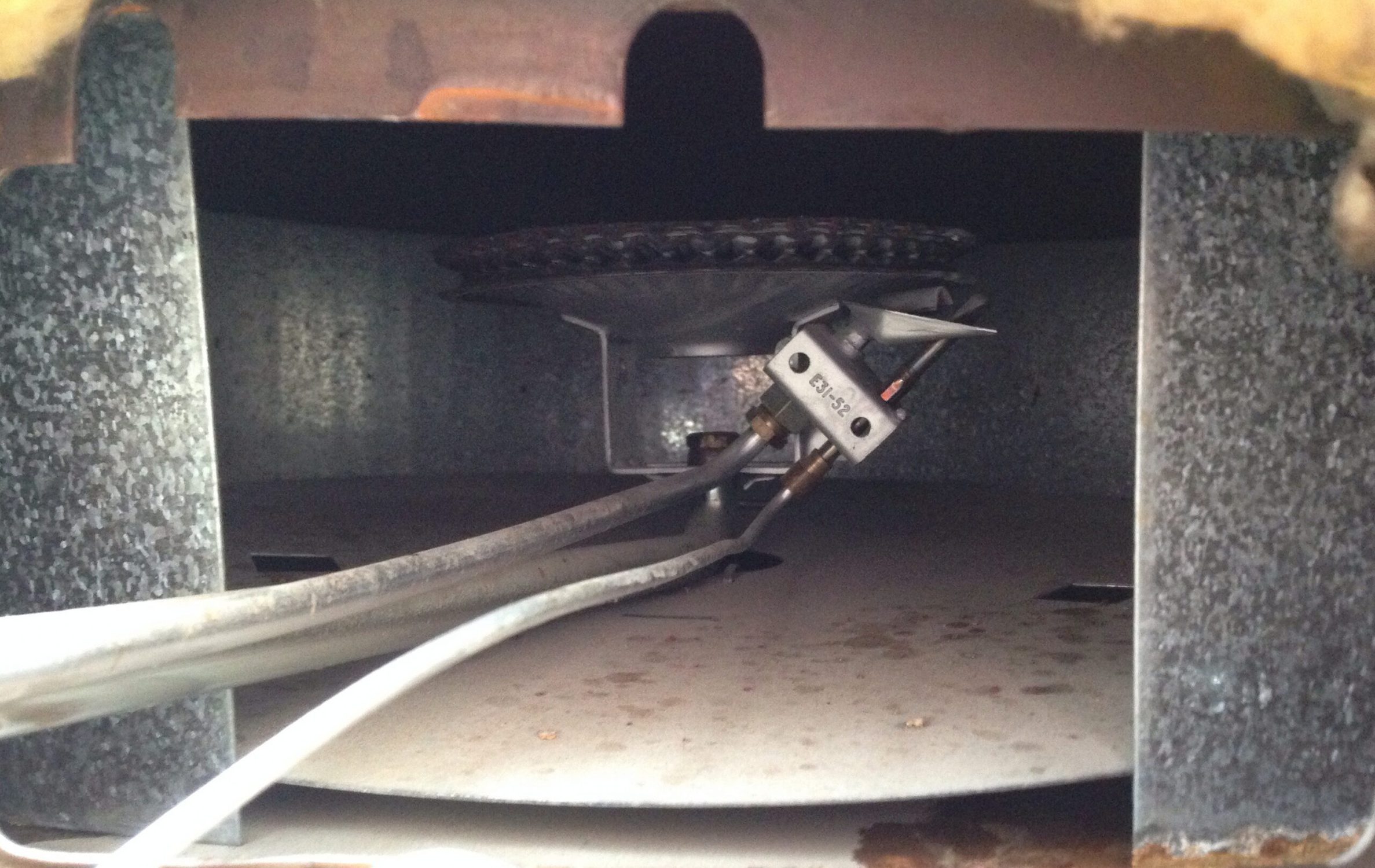
How Does a Water Heater Work?
All water heaters do one job and that is to heat water, but the way it’s done is quite different.
Gas or Electric Tank Water Heater
The tanked water heater works similarly, except for the means of heating the water. Let’s look, step-by-step, at what happens inside your water heater.
Cold water is piped into the inner tank of the water heater through the dip tube. The cold water is introduced to the bottom of the tank.

- Cold water is piped into the inner tank of the water heater through the dip tube. The cold water is introduced to the bottom of the tank.
- With the introduction of cold water, the thermostat will register that the water temperature has dropped. a. In the case of a gas heater, the regulator will send gas to the burner, where the pilot light will ignite it. b. In the electric heater, the thermostat will complete an electrical circuit that will send electricity to the electrical element at the bottom of the tank.
- The hot water slowly rises toward the top of the tank, and as it cools, it’ll slowly sink toward the bottom of the tank.
- When the thermostat finds that the water in the tank is at the required temperature, it’ll turn off the heat source.
- The water inside the inner tank is pressurized. When a hot water faucet is opened anywhere in the building, the hot water is pushed out of the inner tank into the hot water supply pipes and is sent to the faucet.
- This lowers the pressure inside the tank, and cold water comes in, starting the process all over again.

How Does a Tankless Water Heater Work?
In recent years, tankless heating systems have gained popularity. This uses considerably less energy on an ongoing basis as there’s no water tank to keep hot.
The water is heated as is required. This type of water heater uses a heat exchanger, similar to those found in air conditioning or refrigeration units; the only difference is that the pipes are heated externally. The water flows inside the tubes, absorbing heat as they go.
Let’s look at how it works:
- A faucet is turned on in the building, which initiates water flowing into the water heater. This is detected by a flow meter, and this turns on the heating mechanism.
- Heating of the water can be done by gas (either propane or natural gas) or electricity. a. In a gas-powered heater, the flame’s height is dictated by the demand for water at any given time. The flame will heat the pipes inside the heat exchanger unit, and the water flows through the pipes, absorbing heat as it passes through. b. In an electrical unit, the electrical elements will heat the lines. As the water passes through them, it absorbs the heat from the pipes.
- Once the water has passed through the heat exchanger, it’s hot and is then moved through the building’s plumbing system to the faucets.
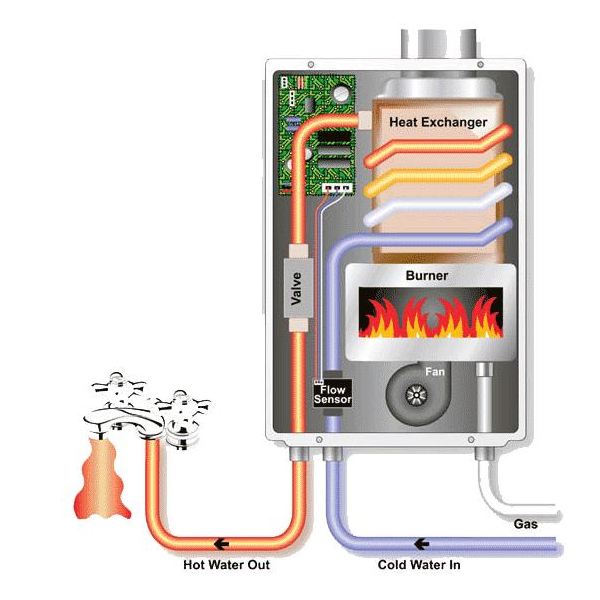
How Does a Hybrid Water Heater Work?
Hybrid water heaters are also known as heat pump water heaters. This type of water heater will only work on electricity. It works on the same principle as an air conditioner, only in reverse.
This type of water heater uses heat from the outside air to heat water. Inside the evaporator coil is a refrigerant liquid that absorbs heat from the air drawn in over the coils. As the refrigerant absorbs the heat, it becomes a gas and is passed on to a heat exchanger. In the heat exchanger, the refrigerant gives up its energy to heat the water passing over them, creating hot water for the building.
Most hybrid systems will fall back on an electrical element when there’s a very high demand for hot water and the heat exchanger can’t meet the demand.
This type of water heater doesn’t work efficiently in cooler climates as there’s insufficient heat in the air to warm the water.
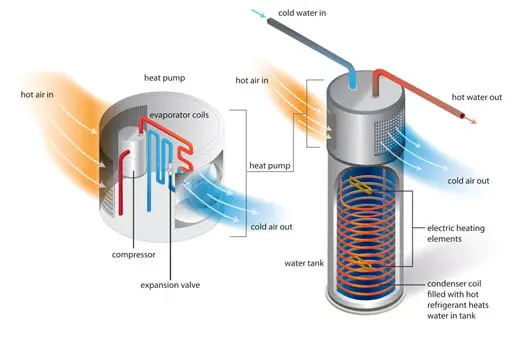
How Does a Point-of-Use Water Heater Work?
The point-of-use water heater is a tankless system that is installed at the faucet that it’s supplying. These units function in precisely the same way as a tankless water heater, with the exception that they’re most often electrically powered.
Which Do You Choose?
Each of these water heaters has its good and bad points.
The gas or electric tank type of water heater is the cheapest water heater to buy but can be expensive to run, both in terms of energy used to keep the tank of water warm and the amount of water wasted waiting for hot water at the faucet. This type of heater is extremely common and is simple to install and maintain.
The tankless type of water heater is expensive to purchase but will save money in the long run in terms of energy usage.
The point-of-use water heater is very energy efficient. It wastes no water as it’s installed right where the hot water faucet is.
The heat pump type of water heater can be combined with an air conditioning unit. In hot climates, it can be an efficient means of warming water.
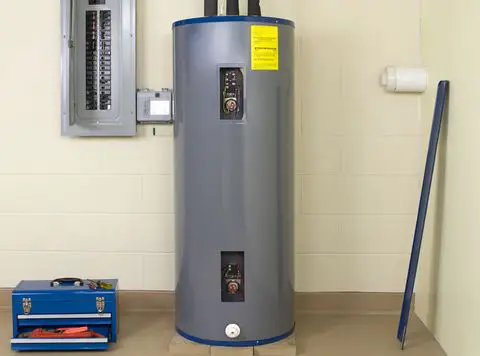
Conclusion
As we have seen, each type of water heater has benefits, and selecting the right one depends on several factors. These factors include your budget, the space you have to install one, the length of plumbing to get hot water to the faucet, and the area you live in.
